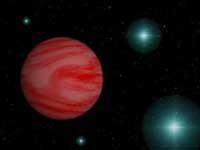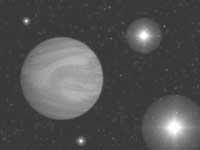Brown dwarfs: Failed stars or failed planets?
2001/11/15 Carton Virto, Eider - Elhuyar Zientzia
Failed stars
The body detected in 1995 is called brown nano and the nickname ‘failed star’. In fact, it was considered a corpus that did not become a star due to its scarce mass. In other words, it began to form as the stars do, but the process was halfway through. Stars are formed in the clouds of gas when the force of gravity contracts the gas. In this way, a sphere of gas is created that rotates and is fed with gas in the cloud. As the size of the star and the force of gravity increases, the pressure at the center of the sphere increases and at any given moment nuclear reactions begin to occur. In short, a star will be born.

In brown dwarfs, on the other hand, nuclear reactions never occur because they have not enough mass to contract the core of the sphere. Nuclear reactions require at least 8% of the mass of the Sun, while brown dwarfs have less mass. They are failed stars.
Failed planets
But as often happens in science, this circular theory did not last long. More brown dwarfs of all the masses were found and they began to suspect that the giant planets were but failed stars. The planets are born around the stars and feed on the material of their sphere. Therefore, normally the planets revolve around the stars. Brown dwarfs float freely in space. However, gravitational interactions can cause the expulsion of the planets from the generation systems. From there, it was proposed that brown dwarfs could be giant planets expelled from their original systems at the beginning of formation.
The debate has not yet been clarified and, in addition, it is possible that both theories are true. That is, brown dwarfs of smaller mass have been born as the planet and those of greater mass as stars. Italian astronomers have used the ISO telescope to solve the mystery. The study of brown dwarfs is not easy as they do not emit light, but thanks to the ISO telescope tools, research has been possible.
Instructions ISO
The study consisted of observing brown dwarfs and detecting the presence or not of gas discs in the surroundings. The Italians studied three brown dwarfs and concluded that they formed as stars. Subsequently, it has been possible to conclude that the mass of these dwarfs is between 4 and 9% of the mass of the Sun. This discovery reinforces the theory that brown dwarfs are failed stars, but does not contradict the other. Now they want to analyze those of lower mass to see if they also have disk. But this is when the next generation of telescopes extend into space. Meanwhile, a selection of brown dwarfs, more suitable for research, is being made.

Gai honi buruzko eduki gehiago
Elhuyarrek garatutako teknologia





